CALCode Quarterly Winter 2024
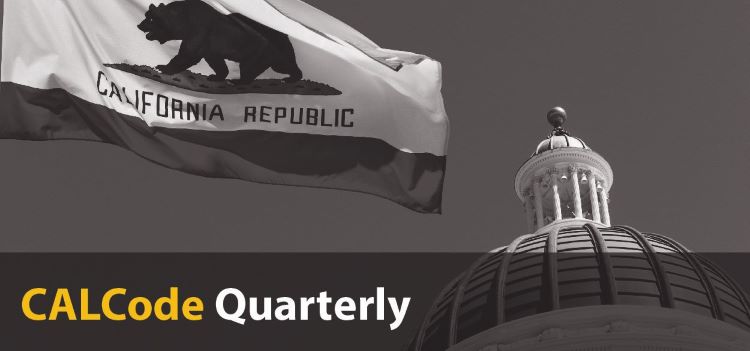
 Stoyan Bumbalov
Stoyan Bumbalov
Happy holidays to you! I hope that you are having an enjoyable conclusion to 2024, and are looking forward to a bright 2025. As the year winds to a close, the California Building Standards Commission (CBSC) is wrapping up the 2024 Triennial Code Adoption Cycle with two commission meetings (in December and January) to adopt and approve building regulations for the next edition of the California Building Standards Code, Title 24 of the California Code of Regulations (Title 24). Take a look at our featured article about the status of the cycle.
On Friday, December 27, we published the final Information Bulletin (IB) of 2024 that summarizes legislative activities impacting CBSC and Title 24. You can view the IB on our News webpage.
We are concluding our year-long celebration of the 15-year anniversary of the California Green Building Standards Code, Part 11 of Title 24, also known as CALGreen. It’s been a rewarding year full of honors from the sustainability industry and meetings with other governments interested in following California’s lead in advancing green building in their jurisdictions. Our final CALGreen feature article for the year will tell you more.
During 2024, CBSC revised its strategic plan in accordance with a statewide goal to embrace diversity, equity, inclusion and accessibility (DEIA) in state agency activities. This was an opportunity for CBSC to review its strategic goals to ensure that DEIA is at the forefront as we undertake the rulemaking process for Title 24. More information about how the strategic plan was updated can be found in the feature article below. Also, I invite you to please complete our public participation poll so we can continue our work to include more interested parties in building code development. We want everyone’s voice to be heard and appreciate your input on how to increase awareness and involvement.
I am pleased to share that we have two team members to spotlight in this issue. First is Carol Hagler, who has been promoted within our office to a Staff Services Manager I (Specialist) role. Second is an introduction to new staff member Havel Weidner, who recently joined the technical staff as an Associate Architect. Learn more about Carol and Havel in our Staff Spotlights.
Finally, members of CBSC’s staff have been participating in various meetings and events virtually and in person, such as a session with Bay Area students interested in green careers, as well as providing cycle updates to some of the state’s building officials. A roundup of our outreach activities this past autumn is provided in this newsletter. If you are having a conference, meeting or other event and would like to invite a speaker or trainer from CBSC, please take a look at our Education and Outreach webpage to see if we can meet your needs and to fill out our speaker/trainer request form.
That’s it for now. On behalf of all of us at CBSC, I wish you a safe and happy new year.
Feature Articles
The 2024 Triennial Code Adoption Cycle will result in the publication of the 2025 edition of the California Building Standards Code, Title 24 of the California Code of Regulations (Title 24), that will be published on July 1, 2025, and go into effect on January 1, 2026.
This winter, the California Building Standards Commission (CBSC) will wrap up the 2024 cycle with two commission meetings in December and January. The December meeting was held December 17, and was concluded in one day. At this meeting, the commission reviewed and approved the adoption and amendment of three model codes—the National Electrical Code, the Uniform Mechanical Code and the Uniform Plumbing Code. These model codes are required by state law to be adopted as state regulations, and are then modified by various state agencies to meet California’s unique needs. When approved for adoption, these model codes and amendments become the California Electrical Code (Part 3 of Title 24), the California Mechanical Code (Part 4), and the California Plumbing Code (Part 5).
The state agencies involved with adopting and amending the model codes were the Building Standards Commission (BSC), the Division of the State Architect – Structural Safety (DSA-SS), the Department of Water Resources (DWR), the Department of Housing and Community Development (HCD), the Office of Statewide Hospital Planning and Development (OSHPD, an office within the Department of Health Care Access and Information), and the Office of the State Fire Marshal (SFM).
Additionally, amendments to the California Green Building Standards Code (Part 11 of Title 24, known as CALGreen) were proposed by BSC, DSA-SS and HCD, and were approved and adopted by the commission.
Finally, at the December meeting, two state agencies that adopt their own regulations presented their amendments to the commission for approval and inclusion in the 2025 edition of Title 24. The Department of Consumer Affairs Veterinary Medical Board made amendments to the California Building Code (Part 2 of Title 24), and the California Energy Commission amended the California Administrative Code (Part 1), the California Energy Code (Part 6), and CALGreen (Part 11).
The details for this first round of California code changes can be found on the December Commission Meeting webpage.
In January, a three-day commission meeting is scheduled to review the adoption of the rest of the model codes: the International Building Code, the International Residential Code, the International Wildland-Urban Interface Code, the International Fire Code, and the International Existing Building Code. These model codes are the basis for the California Building Code (Part 2 of Title 24), the California Residential Code (Part 2.5), the NEW California Wildland-Urban Interface Code (Part 7), the California Fire Code (Part 9), and the California Existing Building Code (Part 10), respectively.
When approved by the commission, these parts will contain amendments proposed by BSC, DSA-SS, HCD, OSHPD and SFM. Additionally, amendments will be found in the California Administrative Code (Part 1 of Title 24). Visit the January Commission Meeting webpage for details and information about how to participate in the meeting.
Note that details about changes made to the model codes can be found on the websites of the publishers. Many model code changes are adopted without amendment into the California codes, so it is important to become familiar with those as well as with the state amendments. The model code publishers are:
The International Code Council (ICC)
The National Fire Protection Association (NFPA)
The International Association of Plumbing and Mechanical Officials (IAPMO)
After the commission meetings, the text of the approved and adopted regulations is filed with the California Secretary of State and the process of codification begins. Codification entails working with the publishers to produce the 2025 edition of Title 24 that will be published on July 1, 2025. This process takes five to six months and includes state agency review and approval of the proofs produced by the publisher in an attempt to publish California regulations that are complete and free from errors.
After publication, the new edition of Title 24 does not go into effect until January 1, 2026. This gives code users and the enforcement community six months to review and learn about the code changes. To assist with this, CBSC produces a summary of California code changes that will be available around July 1, as well.
Please visit the CBSC website to view Resources developed to assist with understanding and using Title 24. Questions can also be directed to cbsc@dgs.ca.gov and someone will get back with you promptly.

As 2024 comes to an end, we are also winding down our 15-year anniversary celebration of the 2009 publication of the California Green Building Standards Code (Part 11 of Title 24), also known as CALGreen.
During 2024, CALGreen was honored by the sustainability industry and increased its staff as a means of meeting California’s goals to improve and protect the environment. In the spring 2024 edition of CALCode Quarterly, we announced two awards presented to CBSC in recognition of CALGreen’s impact, and in the summer 2023 edition we detailed legislative mandates for the development of more sustainability-focused building standards. New team members joined CBSC during 2024 to help facilitate meeting those mandates.
This year, CBSC was honored to be invited to share its sustainable building code expertise with representatives from other states and countries looking to “green” their own regulations (learn more in our “Education and Outreach” sidebar). Over the past 15 years, public participation in the CALGreen code development process has increased and we are thankful for everyone’s knowledge and input. It is important for stakeholder groups and members of the public to make their needs and desires known, so agencies responsible for the building standards in CALGreen can make informed decisions regarding next steps in the growth of the code. Many additions and amendments to CALGreen are the direct result of public participation and we appreciate the involvement of passionate advocates for the disciplines covered by CALGreen such as electric vehicle charging, embodied carbon reduction, bicycle parking and more.
Hundreds of people have worked on and influenced the development of CALGreen over the years, from the governor who mandated it, to representatives from the green building and sustainability industries, to CBSC’s veteran and rookie team members who continue to engage with interested parties to grow the code. Each one has left an indelible mark on CALGreen and, indeed, benefitted the entire state of California. Without CALGreen and the work of these dedicated stakeholders and employees, the state would be a lot less “green.”
Arriving Summer 2025
The new edition of CALGreen will be published on July 1, 2025, and will go into effect on January 1, 2026. Upon publication, CBSC will also issue the Guide to the 2025 California Green Building Standards Code - Nonresidential, which provides details about non-residential CALGreen code sections, including explanations of code intent, compliance methods, suggestions, examples, and enforcement tips. The Guide will also provide information about “Changes for 2025” so code users can easily determine where amendments to CALGreen have been made.
Contact Us
Please visit the CALGreen webpage for more information. To speak with a subject matter expert, call the CBSC office at (916) 263-0916 or email cbsc@dgs.ca.gov.
Note that CBSC’s CALGreen expertise is for non-residential occupancies for which it has authority. The Department of Housing and Community Development has authority for CALGreen codes applied residential occupancies. Their guide and other information can be found on the HCD CALGreen webpage.
The California Building Standards Commission (CBSC) recently renewed the Mission and Vision Statements posted on our website as part of our triennial strategic plan update.
CBSC is a commission within the Department of General Services, which is a department within the Government Operations Agency. In 2024, the governor and his cabinet secretaries assigned a goal to all departments to increase awareness about and promotion of diversity, equity, inclusion and accessibility (DEIA) in their activities and deliverables.
While CBSC already strives to include all interested parties in our code development process, and produces accessible content for posting on our website, we embraced this statewide goal and determined that the best method to promote more DEIA in our daily conduct was to update the CBSC Strategic Plan.
The strategic plan is an internal document that specifies intentions and goals that direct CBSC’s efforts relative to:
- Code development at the national and state level
- Public involvement in the code development process
- Improving the quality of Title 24
- Education and training of code users
- Participation in the legislative process
- Promulgation of green building standards
The strategic plan update project was presented to the commissioners in April 2024, and two commissioners participated in the review and editing process. At the October 17, 2024, commission meeting, the final draft was presented to the entire commission and approved by unanimous vote.
While the strategic plan is an internal document, the mission and vision statements from it are shared on CBSC’s About webpage, in the “Duties, Mission, Vision & Challenges” section.
CBSC invites you to check out the updated text on our website and provide feedback so we can continue to improve our services to the diverse communities in California that are affected by the California Building Standards Code, Title 24 of the California Code of Regulations.
Carol Hagler was promoted this month to a Staff Services Manager I (Specialist). In her new role, Carol will retain some of her previous duties relative to website maintenance and legislation, while also assisting with the administration of the building standards adoption process.
CALCode Quarterly checked in with Carol to find out more about her background and objectives.
CALCode Quarterly: You’ve been with CBSC for about three and a half years now, what’s something unique or surprising you’ve learned?
Carol: Well, everything about the code adoption cycle and the development process was brand new to me. Realizing how intimately the various state agencies involved in building standards work together to coordinate their actions was a bit of a surprise. But the most surprising thing might be how very different the experience of working for the state is in this office when compared to so many other accounts I’ve heard. This is a very special crew with incredibly supportive and nurturing leadership. I count myself beyond lucky to have found a home here.
What are you looking forward to learning or doing in your new role?
I’m really excited to learn more about how the language in the code gets settled. The process of deciding what amendments California needs, and how to phrase them for that balance of precision and room for interpretation, intrigues me. I’m also looking forward to seeing the parts of the cycle that have happened outside of my view for the last few years. The learning curve is going to be significant, but deeply engaging.
You have a varied background – neuroscience (!), software development, website development, legislation. How does it all fit together for you?
The common element in all those endeavors is problem solving. Figuring out how to organize information and put it in context with a specific structure is a lot like those brain teasers my youngest brother and I grew up doing for fun. Understanding the requisite structure—whether that’s the syntax of a programming language, the grammatical structure of a paragraph, the impact of physiology on behavior, or the numerous deadlines of a legislative session—goes a long way to being able to figure out how to accomplish specific goals. I enjoy structured puzzles.
That said, there has also been a lot of serendipity and good fortune in how my professional life has played out. I have always made an effort to focus more on the people around me…than on the tasks. That has resulted in some surprising and wonderful moves along the way. It has also enriched my life more than I could ever have dreamed. The people here at CBSC are absolutely contributing to that tapestry already, and surely will…for years to come.
Anything else you’d like to share? Have you started your woodworking hobby yet?
Alas, most of my domestic focus over the last couple of years has been on getting into our [new] home and addressing all the crises that tend to follow that. However, one of my new neighbors has an extensive wood- and metal-working shop set up in his garage. I’m pretty sure I will be able to work a trade of some smoked ribs or something for a few lessons and maybe the use of a few of his tools. In the meantime, I am very happy to be settling into Fair Oaks and becoming more deeply familiar with my new hometown. I’m also amused that this is where I’ve settled because part of my family’s farm has always been in Fair Oaks, Arkansas. It feels like a blessing of sorts.
Please join us in congratulating Carol on her new position at CBSC.
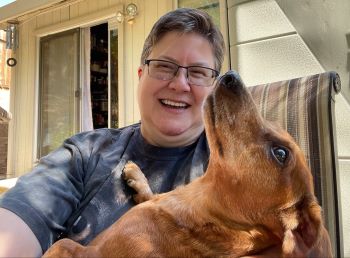
Havel Weidner is CBSC’s newest Associate Architect and joined the technical team this past October. His job duties will focus on the development of building standards for water reuse systems and pre-plumbing of buildings for future use of recycled water and other alternative water sources. As a licensed architect, Havel brings a unique background and extensive experience to CBSC that will be beneficial to the success of the team as they develop new regulations mandated by the legislature.
CALCode Quarterly asked Havel a few questions so we can get to know him a little better.
CALCode Quarterly: Please tell us more about your experiences in architecture in San Francisco and the Bay Area.
Havel: Working as an architect doing renovation projects in the Bay Area gave me professional license (literally) to poke my nose into many different and interesting buildings—on roofs, in attics, in basements below, and behind curtains backstage—which are places I’ve always loved exploring and learning more about. The intricacy, ornamentation, and construction of older buildings is fascinating to examine in person and in old architectural drawings, and a fun challenge to connect with new aesthetics and construction.
What was a favorite project you worked on as an architect?
My favorite of these projects was working on the renovation of a middle school in the same district I went to while I was growing up. The school was originally built in 1937, though it had been renovated a number of times since its original construction. Our project included upgrades for accessibility, ceilings and lighting, new administrative offices, and a new cooking kitchen for making student meals on-site. I worked on the project as designer, and led consultant coordination, drawing production, and client communication. Energy and material efficiency were very important to the client, and all new windows, doors, plumbing fixtures, electrical and mechanical equipment, and lighting installed during the renovation complied with CALGreen and Energy Code standards for efficiency.
Since you’ve joined CBSC, have you learned anything you didn’t expect?
I was surprised to learn how many different state agencies contribute to the Building Standards. There are at least 15 that can propose or adopt standards in Title 24!
You moved to Sacramento from San Francisco. What are you looking forward to in your new city?
As a new resident of the Sacramento area, I’m looking forward to the weather improving a bit and the daylight lasting longer, so I can start exploring the many trails described in a book I recently purchased – “60 Hikes Within 60 Miles of Sacramento.”
Please join us in welcoming Havel to CBSC.
rulemaking Public Participation Poll
The California Building Standards Commission (CBSC) would like to improve and increase public participation in California’s building standards adoption process, known as rulemaking. CBSC administers a rulemaking cycle every 18 months to adopt and amend building codes contained in the California Building Standards Code, Title 24 of the California Code of Regulations (Title 24).
Answers provided in this poll are confidential and exclusively for the use of CBSC to improve its services to the public that is impacted by Title 24. You are not required to provide your name and/or contact information, or to fill in any of the form fields that request more information. Thank you very much for your time.
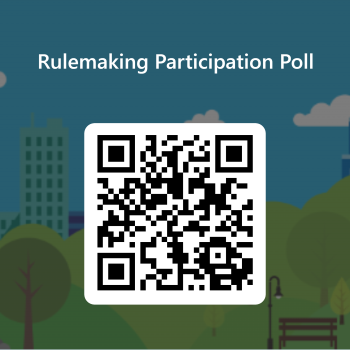
Education and Outreach
Energy Transition Coordinating Council (ETCC) Energy Transition Summit – On October 8, Supervising Architect Irina Brauzman spoke at the Energy Transition Summit in Sacramento, alongside panelists Karin Perissinotto, Sustainability Manager of CalPortland (a building materials company), and Jack Rusk, Director of Climate Strategy at EHDD Architects. Each member of the panel shared a 10-minute presentation about embodied carbon reduction, and answered questions from moderator Dave Intner of SoCal Edison and the audience. Irina talked about the new regulations in the California Green Building Standards Code (Part 11 of Title 24, CALGreen) that provide three different pathways for reducing embodied carbon in buildings.
Canopy’s Green Careers Panel – Associate Construction Analyst Enrique M. Rodriguez joined Dartmouth College Assistant Professor of Environmental Studies Shersingh Joseph Tumber-Davila, PhD, and Deputy Secretary of Environmental Justice and Equity with the California Environmental Protection Agency Yuting ‘Yvonne’ Chi, Esq. on a panel for high school students interested in pursuing environmental studies in college and as a career. The speakers shared their incredible personal journeys as immigrants to this country from humble beginnings to their current careers that influence the course of environmental stewardship in California. The October 16 virtual program was hosted by Canopy Youth Program Manager Juanita Ibarra and was attended by a group of Bay Area high school students. The students asked the panelists about their education and careers, and how they discovered their passion for the environment. In addition to exposing youth to possible green career opportunities, Canopy’s mission is to grow an urban tree canopy in mid-peninsula communities for the benefit of all.
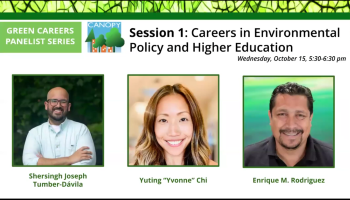
The Canopy Green Careers Speakers
American Wood Council – On November 4, Supervising Architect Irina Brauzman and Principal Architect Eric Driever from the Division of the State Architect met with representatives from the American Wood Council (AWC) to discuss implementation and acceptance of the new embodied carbon reduction regulations in CALGreen. AWC was specifically interested in the reactions of different sectors of code users, such as the design community, building code officials, and contractors, as well as guidance provided to these groups for implementing the code. Irina shared that the CALGreenInfo.com website is available with a wealth of information about all things CALGreen, including the new embodied carbon reduction measures. She also let the group know about CBSC’s Supplement to the CALGreen Guide, which is published after an intervening code adoption cycle to inform code users of new and amended CALGreen regulations.
County Building Officials Association of California (CBOAC) Annual Conference and Business Meeting – Deputy Executive Director Kevin Day and Associate Construction Analyst Beth Maynard attended CBOAC’s 60th annual conference on November 6 in Santa Rosa. Kevin gave a code adoption cycle update as part of the state agency panel that included the Division of the State Architect and the Department of Housing and Community Development. CBSC is always pleased to be able to connect with building officials throughout the state who are the front-line enforcers of Title 24. If we can’t answer your question, we’ll do our best to refer you to the correct entity. If we don’t see you at an event and you have a question, please call (916) 263-0916 or email cbsc@dgs.ca.gov.
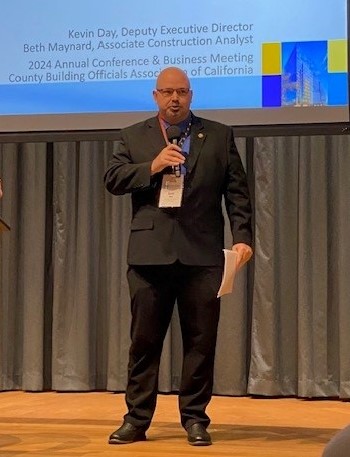
Kevin Day at CBOAC
2025-26 Calendar – CBSC’s new calendar celebrating the publication and effective dates of the 2025 edition of Title 24 is available upon request. You can find a link to request a PDF for printing on our Codes webpage or email cbsctraining@dgs.ca.gov.
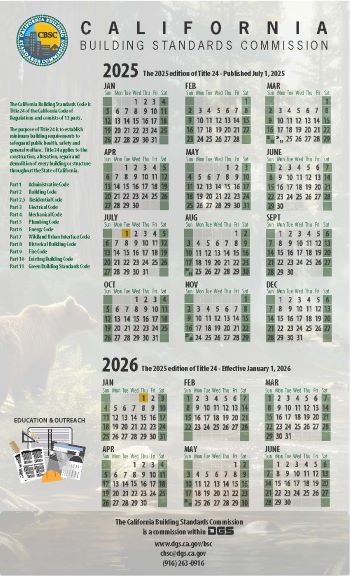
Happy New Year!

